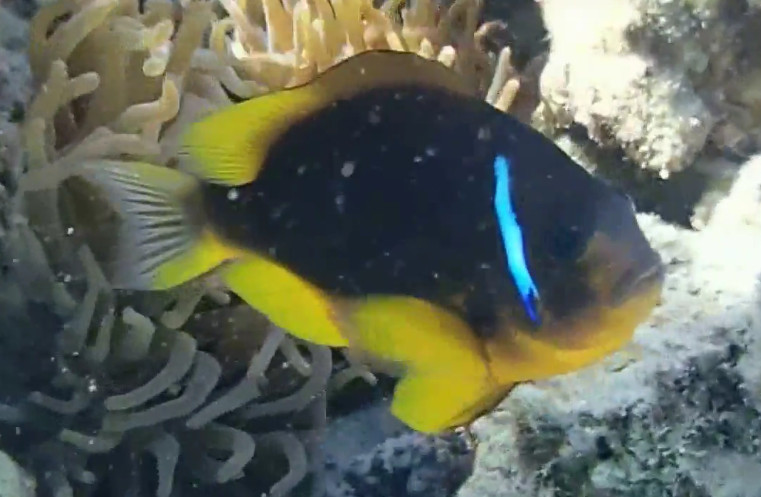There’s only one species of anemonefish recorded from the Red Sea, so, in theory, there should be no great difficulty identifying the fish seen in this video. Is it from the Red Sea? Is it swimming in an anemone? Well then, we’ve got ourselves an Amphiprion bicinctus. But it would seem that not all are created quite the same, as this individual has an unusually dark body and just a single stripe, giving it a rather frenatus-like appearance.
It’s clearly still A. bicinctus, but not like we are used to. The prototypical Red Sea Anemonefish is a cheery yellow-orange, with a brown back and two thick white stripes. Instead, what we have here is a fish that is virtually black throughout, with only the fins retaining the bright yellow hues we would expect of this species. The middle stripe has almost completely disappeared and the anterior stripe is highly reduced and disconnected above the head. The caudal fin is also quite unique, with yellow margins and a sooty interior. Incredibly, this same fish has been filmed in the same anemone by two different recreational divers.
There are some other interesting aberrations of this fish. The next video, from Marsa Alam, Egypt, shows a specimen that is completely lacking the middle stripes, but without the heavy melanism of the previous example.
The clear caudal fin has also been documented elsewhere. The following two videos show one from Dahab, on the Sinai Peninsula and another from an unknown location.
And sometimes specimens have an unusually thickened dark margin to the pelvic fins…
It doesn’t seem like there’s any evolutionary significance to these variations , as the normal phenotype occurs alongside the aberrations. The next few videos show specimens from Makadi Bay, where the black bicinctus was found.
https://youtu.be/eyXOHojwij0?t=4m14s
And here are some from several locations in Saudi Arabia.
And here are are some from Djibouti, at the far south of the Red Sea. These seem essentialy the same as elsewhere, though I’ve yet to see any with the dark body and thin stripes found in the north.
And, just for funsies, here are some more videos from Sudan and other Egyptian locations.











Saw many atypical “bicinctus” in the northern tip of the Gulf of Aqaba, off the shore of Jordan in 2010. Brown/black bodies, white caudal fins, brown/black pelvic fins, narrowed and discontinuous first bar, missing second bars, etc. Like the article mentions, most of these variants were found alongside “traditional” bicinctus. However, most of the atypicals were seen in H. crispa, not E. quadricolor. Further, most were seen in shallower portions of the reef, within several meters of the surface. Some of the fish just looked plain old! Personally I think many of the atypical features strike a cord with A. chagosensis… just saying 🙂
Nice photos. It seems this variation only occurs in the northern portions of the Red Sea. I’ve also noticed the tails are a bit less lunate compared to those from Djibouti. I imagine these two populations have experienced some amount of isolation from one another, or at least more interbreeding with omanensis in the south.
A. chagosensis is quite a different fish in its shape, and the juvenile patterning is quite distinct, lacking the pennant-like flag on the dorsal fin. If you’re talking about the bicinctus-like fish from Chagos, it is quite similar, but the caudal fin shape is more typical of a clarkii, rounded, not lunate.
Really cool stuff. So glad to see the article.